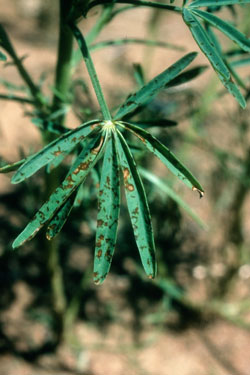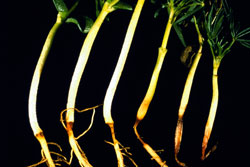Brown leaf spot and root rot of lupins
The most important diseases of lupins in Victoria are brown leaf spot and pleiochaeta root rot, which are both caused by the fungus Pleiochaeta setosa.
Control measures are required to protect the roots and foliage before the disease becomes established in order to minimise crop losses.
What to look for
Pleiochaeta setosa can infect all plant parts, but is usually first seen on the leaves. Leaf, pod and stem infections begin as small, dark brown spots which enlarge to form black networks on leaves, and extensive brown areas on pods and stems.

When leaves are severely infected they die and drop off. Infection up to the four leaf stage can kill seedlings. When pods are heavily infected the fungus may infect the developing seed.
The brown leaf spot fungus may also infect lupins on the upper taproot.
This infection appears as a dark brown lesion and may cause the plant to die, especially when the soil is waterlogged just after sowing.
Other root rotting fungi such as Rhizoctonia and Fusarium species are frequently associated with brown leaf spot infections at the base of the stem.
Economic importance
Pleiochaeta setosa is prevalent in all areas where lupins are grown. Lupin plants may be infected at any stage of growth. Under Victorian conditions Pleiochaeta root rot can reduce establishment, while brown leaf spot is most important from emergence until rapid growth starts in early spring. Later, as lupins approach maturity and are growing rapidly, loss of some lower leaves due to disease has little effect on grain yield.

Disease cycle
The pathogen is carried over from one season to the next on previously infected plant material, in infested seed or as spores on the soil surface. At the start of the next cropping season, spores that survived the summer may become incorporated into the soil with tillage or sowing operations.
When the next lupin crop is sown, soil-borne spores germinate and infect the roots of lupin seedlings. Spores that have survived on the soil surface are splashed upwards by rain droplets, and infect leaves and stem.
During the growing season large numbers of spores are produced when diseased leaves fall onto the soil surface. These spores start new infections when they are splashed onto foliage by rain.
When pods are heavily infected the fungus may infect the developing seed. Sowing infected seed can initiate the disease.
Seed-borne infections are important for dissemination of the pathogen over long distances, and are responsible for initial infection in clean paddocks that are isolated from other lupin crops. Once infection is established within the crop, secondary infection of other plant parts can occur by splash dispersal of fungal spores during rain.
The only other known host for brown leaf spot is serradella, a low-yielding legume which is not common in Victorian lupin areas.
Management
Brown leaf spot and root rot can be effectively controlled when an integrated approach to disease management is implemented. This involves using a number of strategies including:
- crop rotations
- seed dressings
- resistant cultivars
- retaining cereal stubble.
Paddock selection
Crop rotation is an important management strategy as the number of Pleiochaeta spores in the soil is reduced by half every year a non-lupin crop or pasture is grown in the rotation.
Sowing lupins into cereal stubble will reduce rain splash of spores onto lupin plants. Long rotations are important so that lupin stubble will be decomposed before the next lupin crop is sown.
Sowing
Sowing seed deeper places the emerging lupin roots below the spores, reducing the chance of pleiochaeta root rot.
Plan to sow at the optimum time for your district. For optimal sowing time for your district refer to the Victorian Winter Crop Summary.
Seed selection
Only retain seed from crops that have little or no disease as Pleiochaeta setosa can be seed borne.
Seed treatment
Another important method for controlling brown leaf spot is to apply a seed dressing, although this only suppresses the disease and does not provide complete control.
Registered seed treatments containing either iprodione or procymidone will reduce the transfer of the disease to the seedling, and can reduce leaf drop by 50 per cent.
Variety selection
Variety selection is also an important management strategy.
New narrow leaf lupin varieties (Lupinus angustifolius) have been released with resistance to pleiochaeta root rot and brown leaf spot.
Broad leaf or Albus lupin (Lupinus albus) varieties are available with tolerance to brown leaf spot, but can be susceptible to root rots under wet conditions and so are limited to well-drained soils.
For further information on disease ratings refer to the Victorian Winter Crop Summary.
Recommendations for control of brown leaf spot
- Develop long crop rotations and avoid planting lupins in paddocks adjacent to lupin stubble.
- Sow into a cereal stubble to reduce the amount of rain splashed spores.
- Treat all seed with a recommended fungicide and ensure that seed lots are free from plant debris.
- Use brown lead spot resistant cultivars.
Further references
Detailed information on each of the pulse diseases can be obtained from:
- Agriculture Victoria Information Notes
- Lupin Southern Region – GrowNotes™
- Pulse Australia
- National Variety Trials
- Victorian Winter Crop Summary
- Victorian Pulse Disease Guide
- Pulse Seed Treatments and Foliar Fungicides
Contact
Field Crops Pathology
Grains Innovation Park
110 Natimuk Rd
Horsham 3400
Telephone: 03 5450 8301
Pulse Pathologist – Horsham
Dr Joshua Fanning
Contact: 0419 272 075
Or call the Customer Service Centre, 136 186
Acknowledgements
Mary Raynes, Helen Richardson, Trevor Bretag and Luise Sigel. Support by the Support by the Grains Research and Development Corporation is gratefully acknowledged.